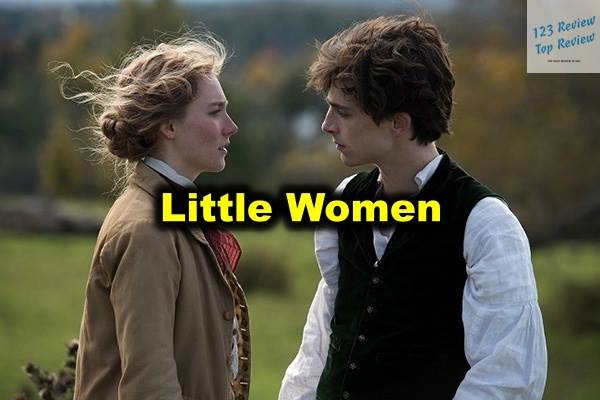In this article, 123 Review delves into the historical context of the story, the evolution of the film adaptations, and the profound themes of sisterhood, feminism, and social class that have resonated across generations. We also provide a detailed character analysis, examine the cinematic elements in Gerwig’s adaptation, and discuss the critical reception and educational impact of this timeless story.

Overview of Little Women Adaptations
Historical Context of the Novel
Louisa May Alcott’s Little Women, published in two volumes in 1868 and 1869, is one of the most enduringly beloved works of American literature. Set against the backdrop of the Civil War in New England, the novel tells the coming-of-age story of the four March sisters—Jo, Meg, Beth, and Amy—as they navigate the complexities of adolescence, womanhood, and the shifting expectations placed on them by society. Alcott drew inspiration from her own experiences growing up in a large, impoverished family in Concord, Massachusetts. Her father, Bronson Alcott, was a transcendentalist philosopher and educator whose progressive ideas influenced the novel’s themes of self-reliance, individualism, and social justice. Little Women was groundbreaking for its time, offering a rich portrayal of female characters who were complex, flawed, and driven by their own ambitions. Alcott’s writing resonated with readers who were accustomed to more simplistic, idealized depictions of women. The novel’s exploration of themes such as love, family, independence, and sacrifice, combined with its realistic portrayal of domestic life, helped cement its status as a classic. Over 150 years later, Little Women remains a touchstone for discussions about gender roles, family dynamics, and the ways in which personal aspirations can be reconciled with societal expectations.
Evolution of Film Adaptations
Given its widespread acclaim and timeless appeal, it’s no surprise that Little Women has been adapted into numerous films, each bringing a unique perspective to Alcott’s narrative. The story’s first cinematic incarnation came in 1917 as a silent film, directed by Alexander Butler. This early version, though lost to history, set the stage for the many adaptations that followed. The most iconic early adaptation was George Cukor’s 1933 film, starring Katharine Hepburn as Jo March. Cukor’s adaptation was celebrated for its fidelity to the source material and its ability to capture the novel’s spirit within the constraints of early sound cinema. Hepburn’s portrayal of Jo became a defining interpretation of the character, her performance embodying the fiery independence and ambition that Alcott had written into her protagonist. In 1949, Mervyn LeRoy directed another adaptation of Little Women, this time in Technicolor, with June Allyson as Jo and Elizabeth Taylor as Amy. This version leaned more into the romantic and melodramatic elements of the story, reflecting the cinematic trends of the post-war era. It was notable for its lush production design and strong performances, particularly Taylor’s portrayal of Amy, which added a dimension of glamour and complexity to the youngest March sister. The 1994 adaptation, directed by Gillian Armstrong, marked a significant shift in the way Little Women was presented on screen. Starring Winona Ryder as Jo, this version was praised for its nuanced performances and its feminist undertones, which resonated with the growing conversations around gender and identity in the 1990s. Armstrong’s film stayed true to the novel’s period setting while also emphasizing the modern relevance of its themes. The film’s strong emphasis on the sisters’ individual journeys and its attention to the details of their domestic life made it a richly textured adaptation that appealed to both longtime fans of the novel and new audiences.
Comparison of Different Versions
When comparing the various film adaptations of Little Women, it becomes evident how each version reflects the cultural and cinematic norms of its time while also offering a distinct interpretation of the novel’s characters and themes. The 1933 adaptation, for instance, is deeply rooted in the values of its era, emphasizing the importance of family unity and resilience during times of hardship—sentiments that would have resonated with Depression-era audiences. Katharine Hepburn’s Jo is a character of her time: strong-willed and independent, yet ultimately accepting of her role within the family and society.
In contrast, the 1949 adaptation places greater emphasis on the romantic and sentimental aspects of the story. The film’s Technicolor palette and glamorous production design reflect the optimism and escapism of the post-war period. While June Allyson’s Jo retains the character’s fiery spirit, this version softens some of the novel’s feminist undertones, focusing more on the sisters’ romantic entanglements and the ideal of domestic bliss.
The 1994 adaptation, directed by Gillian Armstrong, offers a more introspective and modern take on the story. Winona Ryder’s Jo is portrayed with a mix of vulnerability and defiance, highlighting the character’s internal struggles as well as her outward rebellion against societal norms. This version also brings more attention to the individual desires and conflicts of each sister, exploring how they navigate their ambitions within the constraints of their social and economic circumstances. The film’s feminist overtones are more pronounced, reflecting the evolving conversations about women’s rights and gender equality in the 1990s.
These adaptations demonstrate how Little Women has been reinterpreted over the decades to resonate with changing cultural attitudes and cinematic styles. Each version brings its own strengths to the table, offering audiences a different lens through which to view Alcott’s timeless story.
Greta Gerwig’s Adaptation
Directorial Vision and Style
Greta Gerwig’s 2019 adaptation of Little Women stands out not only for its innovative narrative structure but also for its clear and compelling directorial vision. Gerwig, who had previously garnered acclaim for her directorial debut Lady Bird, approached Little Women with a deep understanding of both the novel’s historical context and its contemporary relevance. Her adaptation is not merely a retelling of the March sisters’ story but a reimagining that seeks to connect the past with the present.
Gerwig’s direction is characterized by its warmth, vibrancy, and attention to detail. She brings a modern sensibility to the material without losing sight of its period setting. The film is suffused with a sense of intimacy, not just in its depiction of the close-knit relationships between the sisters but also in its visual and narrative style. Gerwig employs a fluid, dynamic camera that often lingers on the characters’ faces, capturing the nuances of their emotions and relationships. This creates a sense of immediacy and connection between the characters and the audience.
One of Gerwig’s most significant contributions to the Little Women canon is her non-linear narrative structure, which juxtaposes scenes from the sisters’ childhood with their adult lives. This approach allows Gerwig to explore the ways in which the characters’ past experiences inform their present decisions and identities. By interweaving the two timelines, Gerwig emphasizes the continuity of the sisters’ emotional journeys and the enduring impact of their relationships with each other. This narrative choice also serves to highlight the themes of memory and nostalgia, making the film as much a reflection on the passage of time as it is a straightforward coming-of-age story.
Non-linear Narrative Structure
The non-linear narrative structure of Gerwig’s Little Women is one of the film’s most distinctive features, setting it apart from previous adaptations. Rather than following the chronological order of the novel, Gerwig intercuts scenes from the March sisters’ childhood with moments from their adult lives. This narrative device allows for a more layered and complex exploration of the characters and their development.
The decision to structure the film in this way is both a creative and thematic one. By presenting the past and present simultaneously, Gerwig emphasizes the idea that our identities are shaped by our memories and experiences. The film’s structure mirrors the way we often remember our own lives—non-linearly, with past events continuously influencing our present selves. This approach also allows Gerwig to draw parallels between the sisters’ experiences as children and adults, highlighting the ways in which they have grown and changed, as well as the ways in which they have remained the same.
For example, Jo’s decision to cut her hair—a pivotal moment in the novel and in the film—is presented alongside scenes from her adulthood, where she struggles with her role as a writer and her place in the world. This juxtaposition underscores the sacrifices Jo has made for her independence and the ways in which her ambitions have both shaped and limited her life. Similarly, Amy’s experiences as a young girl aspiring to be an artist are contrasted with her later reflections on the compromises she has made in pursuit of her goals. This interplay between past and present deepens the emotional impact of the characters’ stories, allowing the audience to see how their childhood dreams and struggles continue to influence their adult lives.
Gerwig’s non-linear structure also enhances the film’s exploration of memory and the passage of time. By weaving together scenes from different periods of the sisters’ lives, the film captures the fluidity of memory and the way in which the past and present are always in conversation with each other. This narrative choice adds a layer of poignancy to the film, as the audience is constantly reminded of the fleeting nature of time and the inevitability of change.
Character Development and Representation
In Gerwig’s adaptation, the character development is particularly rich and nuanced, with each of the March sisters portrayed as a fully realized, complex individual. Gerwig’s approach to character is deeply empathetic, and she takes care to highlight the unique strengths and struggles of each sister, ensuring that their stories are given equal weight and attention.
Jo March, played by Saoirse Ronan, is the film’s central figure, and Gerwig’s depiction of her is both faithful to the novel and refreshingly modern. Jo is portrayed as fiercely independent and ambitious, with a deep passion for writing and a desire to live life on her own terms. However, Gerwig also allows the audience to see Jo’s vulnerabilities—her fear of loneliness, her struggle with societal expectations, and her evolving understanding of love and relationships. Ronan’s performance captures this complexity, making Jo a character who is both relatable and inspiring.
Meg March, portrayed by Emma Watson, is depicted as the embodiment of traditional values, but Gerwig’s adaptation gives her character depth beyond her role as the “domestic” sister. Meg’s desire for a conventional life, including marriage and family, is portrayed not as a weakness but as a valid and fulfilling choice. Gerwig respects Meg’s decision to embrace these roles, while also exploring the challenges and sacrifices that come with them. Watson’s portrayal of Meg highlights her quiet strength and the dignity with which she pursues her dreams of love and stability.
Amy March, played by Florence Pugh, is perhaps the most transformed character in Gerwig’s adaptation. Traditionally seen as the spoiled and vain youngest sister, Amy is given new depth and complexity in this version. Gerwig portrays Amy as a determined and ambitious young woman who is acutely aware of the limitations placed on her by her gender and social class. Pugh’s performance is both fiery and introspective, capturing Amy’s journey from a self-centered child to a mature woman who understands the value of both love and ambition. Amy’s relationship with Laurie, played by Timothée Chalamet, is also given more nuance, with Gerwig exploring the genuine connection and mutual respect that develops between them.
Beth March, the quietest and most selfless of the sisters, is portrayed with gentle sensitivity by Eliza Scanlen. Gerwig’s adaptation stays true to Beth’s role as the moral center of the family, but it also delves deeper into her character, exploring her love of music, her sense of duty, and her acceptance of her own mortality. Scanlen’s performance is understated yet powerful, conveying the quiet strength and inner peace that define Beth’s character. Gerwig’s handling of Beth’s illness and death is both respectful and deeply moving, underscoring the impact of her loss on the entire family.
Overall, Gerwig’s approach to character development in Little Women is both thoughtful and progressive. She presents each of the March sisters as a fully realized individual, with their own dreams, struggles, and triumphs. By doing so, she ensures that the film resonates with modern audiences while remaining true to the spirit of Alcott’s novel.
Character Analysis
Jo March: The Ambitious Protagonist
Jo March, the second eldest of the March sisters, is the heart and soul of Little Women. As portrayed by Saoirse Ronan in Greta Gerwig’s adaptation, Jo is a character of extraordinary depth and complexity, embodying the tension between societal expectations and personal ambition that lies at the core of the novel. Jo is fiercely independent, with a passion for writing that drives her to push against the limitations placed on women of her time. Her desire to break free from traditional gender roles and carve out a life of her own makes her one of literature’s most enduring feminist icons.
In Gerwig’s film, Jo’s ambition is both her greatest strength and her greatest source of conflict. She is determined to pursue a career as a writer, even if it means rejecting the conventional path of marriage and domesticity that is expected of her. However, Jo’s journey is not without its struggles. She faces numerous obstacles in her quest for independence, from the financial hardships of her family to the societal pressures that seek to confine her to a more traditional role. Ronan’s portrayal captures the internal conflict that Jo experiences as she navigates these challenges. On the one hand, Jo is unwavering in her commitment to her dreams, but on the other hand, she is deeply affected by the loneliness and isolation that come with choosing a path that diverges from the norm.
Jo’s relationship with her family, particularly her sisters, is another key aspect of her character. She is fiercely protective of her sisters and often takes on the role of leader within the family. Her bond with Beth, in particular, is one of the most poignant relationships in the film. Jo’s grief over Beth’s illness and eventual death is a turning point in her character arc, forcing her to confront her own vulnerabilities and reassess her priorities. This loss, coupled with her evolving understanding of love and relationships, leads Jo to a more nuanced view of independence and fulfillment.
Gerwig’s adaptation also explores Jo’s relationship with Laurie, her best friend and confidant. The film delves into the complexities of their friendship, particularly Laurie’s unrequited love for Jo and her eventual rejection of his proposal. This decision is a defining moment for Jo, as it underscores her commitment to her own identity and ambitions. However, Gerwig’s portrayal of this relationship is not one-dimensional; she also highlights the deep affection and mutual respect that Jo and Laurie share, making their relationship one of the most compelling aspects of the film.
Meg March: The Pursuit of Love and Family
Meg March, the eldest of the March sisters, is often seen as the most conventional of the four, embodying the 19th-century ideal of womanhood. However, Greta Gerwig’s adaptation adds depth to Meg’s character, portraying her as a woman who actively chooses her path in life rather than passively accepting societal expectations. Emma Watson’s portrayal of Meg captures the character’s warmth, kindness, and strong sense of duty, while also highlighting her internal conflicts and desires.
Meg’s primary aspiration is to create a loving home and family, a goal that is often juxtaposed against Jo’s ambition for independence. While Meg’s dreams may appear traditional, Gerwig’s film emphasizes that they are no less valid or significant than Jo’s. Meg’s decision to marry John Brooke, a poor tutor, rather than pursue a more advantageous match, is a testament to her belief in love and the importance of personal integrity. This choice reflects Meg’s strength of character and her determination to live according to her own values, even if it means sacrificing material comfort.
Gerwig’s adaptation also explores the challenges that Meg faces in her marriage. Despite her deep love for John, Meg struggles with the financial difficulties that come with their modest lifestyle. The film does not shy away from depicting the realities of Meg’s life as a wife and mother, showing the moments of frustration and doubt that accompany her role. However, it also portrays the fulfillment that Meg finds in her family, highlighting the joy and satisfaction she derives from her relationships with her husband and children.
Meg’s character arc in the film is one of self-acceptance and the realization that her worth is not defined by societal standards or material wealth. Gerwig’s portrayal of Meg is deeply empathetic, presenting her as a woman who knows her own mind and is content with the choices she has made. This nuanced depiction allows Meg to emerge as a fully realized character whose story is just as important as those of her more unconventional sisters.
Amy March: Artistic Growth and Ambition
Amy March, the youngest of the March sisters, has often been dismissed as the spoiled, selfish one. However, Greta Gerwig’s adaptation reimagines Amy as a complex, ambitious character with her own unique journey of growth and self-discovery. Florence Pugh’s portrayal of Amy is both dynamic and sympathetic, capturing the character’s evolution from a vain, self-centered child to a mature, determined woman who understands the value of both love and ambition.
In Gerwig’s film, Amy’s ambition is a central aspect of her character. From a young age, Amy is acutely aware of the social and economic limitations placed on women, and she is determined to secure a future for herself that offers both stability and fulfillment. This ambition drives her to pursue a career as an artist, but it also influences her views on marriage and relationships. Amy is pragmatic about the role that marriage plays in securing a woman’s future, and she is unafraid to voice her concerns about the sacrifices that women are expected to make in the name of love.
Amy’s relationship with Laurie is a key element of her character arc in the film. While Laurie initially sees Amy as a replacement for Jo, Gerwig’s adaptation allows their relationship to develop on its own terms. Amy’s refusal to settle for anything less than genuine love and respect is a testament to her growth as a character. By the time she and Laurie marry, Amy has emerged as a woman who understands her own worth and is determined to live life on her own terms.
Gerwig’s portrayal of Amy also emphasizes her artistic aspirations and the struggles she faces in pursuing them. Unlike Jo, who is driven by a passion for writing, Amy’s relationship with art is more complex. She is talented and ambitious, but she is also aware of the limitations and challenges that come with being a female artist in a male-dominated world. The film explores Amy’s internal conflict between her artistic dreams and the practical realities of her life, ultimately presenting her as a character who learns to balance her ambitions with her responsibilities.
Beth March: Innocence and Talent
Beth March, the third of the March sisters, is often seen as the moral center of Little Women. Her quiet, selfless nature and her love of music make her a beloved figure in both the novel and its adaptations. In Greta Gerwig’s film, Beth is portrayed by Eliza Scanlen with a gentle sensitivity that captures the character’s essence. Beth’s innocence, humility, and deep love for her family are central to her character, and Gerwig’s adaptation honors these qualities while also exploring the deeper aspects of her personality.
Beth’s love of music is a significant part of her character in the film, and it is through her music that she expresses herself and finds solace. Her relationship with Mr. Laurence, the family’s wealthy neighbor, is one of the most touching aspects of the story. Mr. Laurence’s gift of a piano to Beth is a pivotal moment in the film, symbolizing his recognition of her talent and his desire to bring joy to her life. Beth’s gratitude and humility in response to this gift further underscore her character’s goodness and the impact she has on those around her.
Beth’s illness and eventual death are among the most heart-wrenching moments in Little Women, and Gerwig’s adaptation handles these events with great care and sensitivity. The film portrays Beth’s illness as a gradual decline, allowing the audience to see the toll it takes on both her and her family. Beth’s acceptance of her fate is depicted with a quiet dignity, and her death serves as a catalyst for the other characters to reflect on their own lives and relationships.
Beth’s character arc is one of quiet strength and grace. Despite her fragile health, she remains a source of comfort and inspiration for her family. Gerwig’s adaptation ensures that Beth’s story is given the attention it deserves, highlighting her importance within the March family and the lasting impact she has on her sisters.
Themes and Motifs
Sisterhood and Family Bonds
One of the most enduring themes of Little Women is the bond between the March sisters and the strength of their family ties. The film’s exploration of sisterhood is both tender and realistic, capturing the complexities of these relationships. Gerwig’s adaptation emphasizes the ways in which the sisters support and challenge each other, portraying their bond as a source of both comfort and conflict.
The March sisters’ relationship is characterized by a deep love and loyalty, but it is also marked by moments of jealousy, competition, and misunderstanding. Gerwig’s film does not shy away from depicting these tensions, showing how the sisters navigate their differences and grow together over time. The film also highlights the role of Marmee, their mother, in fostering this sense of unity and encouraging her daughters to pursue their individual dreams.
The theme of family bonds extends beyond the immediate family to include the broader community of characters who influence the sisters’ lives. The relationships between the March family and characters like Laurie, Mr. Laurence, and Aunt March add depth to the film’s exploration of family dynamics. These connections reinforce the idea that family is not just about blood relations but also about the bonds we form with others who share our lives.
Gender Roles and Feminism
Little Women is often hailed as a feminist text, and Greta Gerwig’s adaptation brings this aspect of the story to the forefront. The film explores the limitations placed on women in the 19th century and the ways in which the March sisters challenge these constraints. Each sister’s journey reflects a different aspect of the struggle for gender equality, from Jo’s rejection of traditional gender roles to Amy’s pragmatic approach to marriage as a means of securing her future. Gerwig’s film also emphasizes the importance of economic independence for women. Jo’s pursuit of a writing career is not just about fulfilling her creative ambitions; it is also about achieving financial autonomy. The film highlights the financial pressures faced by the March family and the impact these pressures have on the sisters’ choices and opportunities. By exploring these themes, Gerwig’s adaptation underscores the relevance of Little Women to contemporary discussions about gender and economic inequality.
The film’s feminist themes are further reinforced by its portrayal of female creativity and ambition. Jo’s writing, Amy’s art, and Beth’s music are all depicted as vital aspects of their identities, and the film celebrates their talents and achievements. However, the film also acknowledges the challenges that come with pursuing these ambitions in a society that often devalues women’s contributions. This tension between personal fulfillment and societal expectations is a central theme of the film, reflecting the ongoing struggle for gender equality.
Love versus Independence
The tension between love and independence is a central theme in Little Women, and it is explored in depth in Greta Gerwig’s adaptation. Each of the March sisters grapples with the question of how to balance their personal desires with the expectations of society, particularly when it comes to love and marriage.
For Jo, the pursuit of independence is paramount, and she is willing to forgo romantic relationships in order to achieve her goals. However, Gerwig’s film also delves into Jo’s internal conflict over her choices. While she is determined to live life on her own terms, she also experiences moments of doubt and loneliness, particularly after rejecting Laurie’s proposal. This portrayal adds complexity to Jo’s character, showing that her desire for independence is not without its sacrifices.
Meg’s story, on the other hand, is one of embracing love and domesticity. Her decision to marry John Brooke is portrayed as a conscious choice, one that reflects her values and desires. However, the film also explores the challenges that come with this choice, particularly the financial difficulties that Meg and John face. Gerwig’s adaptation emphasizes that Meg’s pursuit of love and family is no less valid or significant than Jo’s pursuit of independence.
Amy’s journey is perhaps the most complex in terms of the theme of love versus independence. While she initially seems focused on securing a wealthy marriage, her relationship with Laurie reveals her deeper understanding of love and partnership. By the time she marries Laurie, Amy has come to value love and mutual respect as essential components of a successful marriage. This evolution in her character highlights the idea that love and independence are not mutually exclusive but can be harmoniously integrated.
Social Class Struggles
Social class and economic hardship are recurring themes in Little Women, and they play a significant role in shaping the lives and choices of the March sisters. Gerwig’s adaptation emphasizes the impact of these struggles on the characters’ relationships, ambitions, and sense of self.
The March family’s financial difficulties are a constant presence in the film, influencing everything from Jo’s decision to pursue a writing career to Meg’s marriage to John Brooke. The film portrays the sisters’ awareness of their social status and the limitations it imposes on them, particularly in contrast to characters like Laurie and Aunt March, who come from wealthier backgrounds.
Gerwig’s adaptation also explores the ways in which the sisters navigate these challenges with resilience and creativity. Jo’s writing is both a passion and a means of financial support for her family, while Meg’s decision to marry for love rather than money reflects her belief in the importance of personal integrity over material wealth. Amy’s pragmatic approach to securing her future through marriage is portrayed not as a flaw but as a realistic response to the limitations placed on women in her position.
The theme of social class is also reflected in the film’s portrayal of the broader community in which the March family lives. The contrast between the Marches’ modest home and the wealth of characters like Laurie and Aunt March highlights the disparities in social and economic status that define the world of Little Women. However, the film also emphasizes the value of generosity, kindness, and community, showing how the March family’s relationships with their neighbors and friends transcend social class.
Cinematic Elements
Cinematography and Visual Aesthetics
Greta Gerwig’s Little Women is a visually stunning film, with its cinematography and visual aesthetics playing a crucial role in bringing the story to life. The film’s director of photography, Yorick Le Saux, employs a warm, naturalistic color palette that enhances the film’s nostalgic and intimate atmosphere. The cinematography captures the beauty of the New England landscape, with its rolling hills, snow-covered fields, and picturesque houses, creating a sense of place that is both authentic and evocative.
Gerwig’s use of lighting is particularly effective in conveying the emotional tone of the film. The warm, golden light that bathes the March family home during scenes of joy and togetherness contrasts with the cooler, more muted tones used in moments of sorrow or tension. This careful manipulation of light and color adds depth to the film’s emotional landscape, allowing the audience to feel the warmth and comfort of the March family’s world as well as the challenges and hardships they face.
The film’s visual style is also characterized by its attention to detail, particularly in the depiction of the period setting. From the costumes and interiors to the outdoor scenes, every element of the film’s design is meticulously crafted to evoke the 19th-century world of Little Women. The use of natural light and practical locations enhances the film’s authenticity, making the world of the March sisters feel both lived-in and timeless.
Costume Design and Historical Accuracy
The costume design in Greta Gerwig’s Little Women is both historically accurate and deeply symbolic, reflecting the characters’ personalities, social status, and emotional journeys. The film’s costume designer, Jacqueline Durran, is renowned for her ability to create period-appropriate attire that also speaks to the inner lives of the characters, and her work on Little Women is no exception.
Each of the March sisters is given a distinct visual identity through their costumes, which evolve over the course of the film. Jo’s wardrobe, for example, is characterized by practical, androgynous clothing that reflects her desire for independence and her rejection of traditional gender roles. Her outfits often include elements of men’s clothing, such as vests and trousers, highlighting her defiance of societal expectations.
Meg’s costumes, on the other hand, are more traditional and feminine, reflecting her embrace of domestic life and her role as the eldest sister. Her dresses are often made of soft, delicate fabrics in muted colors, symbolizing her gentleness and nurturing nature. However, her wardrobe also evolves over the course of the film, reflecting her growing confidence and maturity.
Amy’s costumes are perhaps the most varied and elaborate, reflecting her journey from a spoiled child to a sophisticated woman. Her outfits are often colorful and fashionable, highlighting her artistic sensibility and her desire to make a good impression on society. However, as Amy matures, her wardrobe becomes more refined and elegant, reflecting her growth as a character.
Beth’s costumes are the simplest and most understated, reflecting her quiet, selfless nature. Her clothing is often in soft, neutral colors, symbolizing her humility and the role she plays as the moral center of the family. The simplicity of her wardrobe also highlights the contrast between her character and her more outwardly ambitious sisters.
In addition to reflecting the characters’ personalities, the costumes in Little Women are also meticulously researched to ensure historical accuracy. Durran’s attention to detail in the fabrics, cuts, and accessories of the period clothing helps to create a sense of authenticity that enhances the film’s immersive quality. The costumes not only transport the audience to the 19th century but also serve as a visual representation of the characters’ inner lives and emotional journeys.
Soundtrack and Score
The soundtrack and score of Little Women play a crucial role in shaping the film’s emotional tone and enhancing its narrative. The film’s composer, Alexandre Desplat, is known for his ability to create evocative and memorable scores, and his work on Little Women is no exception. The music in the film is both poignant and uplifting, capturing the spirit of the March sisters and the world they inhabit.
Desplat’s score is characterized by its use of delicate, melodic themes that are woven throughout the film, creating a sense of continuity and emotional resonance. The music often mirrors the mood of the scenes, with gentle piano and strings accompanying moments of introspection or sorrow, and more lively, orchestral arrangements underscoring scenes of joy and celebration. This careful orchestration of the score enhances the film’s emotional impact, allowing the audience to connect more deeply with the characters and their experiences.
In addition to the original score, the film also incorporates period-appropriate music, including folk songs and classical pieces, that adds to the authenticity of the setting. These musical choices help to immerse the audience in the world of the March sisters, while also reinforcing the themes of family, tradition, and personal growth.
The use of music in Little Women is not limited to the score; it also plays a significant role in the narrative itself. Beth’s love of music, for example, is a central aspect of her character, and her piano playing serves as a recurring motif throughout the film. The scenes in which Beth plays the piano are among the most emotionally charged in the film, and the music becomes a symbol of her innocence, talent, and the impact she has on those around her.
Conclusion
Greta Gerwig’s adaptation of Little Women is a masterful reimagining of a beloved classic, one that honors the spirit of Louisa May Alcott’s novel while bringing a fresh perspective to its themes and characters. Through thoughtful character development, nuanced exploration of themes, and stunning cinematic elements, Gerwig’s Little Women offers a rich and layered portrayal of the March sisters and their world. The film’s focus on the complexities of female identity, ambition, and relationships makes it a powerful and relevant work for contemporary audiences. Gerwig’s adaptation captures the timeless appeal of Little Women while also highlighting the ways in which its themes continue to resonate in today’s world. Whether through its exploration of sisterhood, its feminist undertones, or its celebration of female creativity, Little Women remains a poignant and inspiring story of love, family, and the pursuit of one’s dreams. In the end, Little Women is a film that invites viewers to reflect on their own lives and relationships, challenging them to consider the ways in which they navigate the balance between personal ambition and the expectations of society. Through its rich characters, compelling themes, and beautiful cinematography, Gerwig’s adaptation ensures that Little Women will continue to be a source of inspiration and reflection for generations to come.





